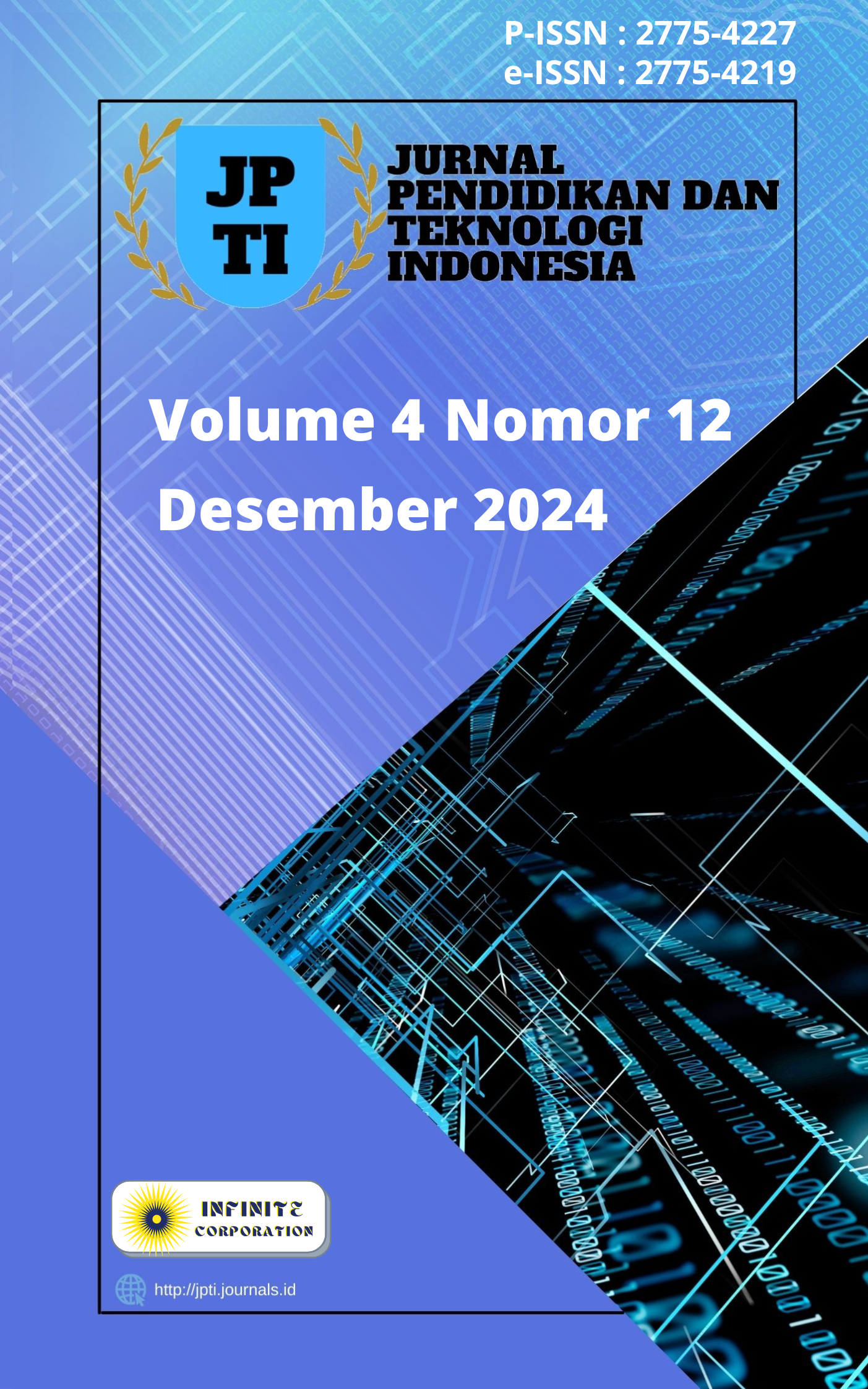Identifying Phonological Interference of Indonesian Multilingual Learners at Reading Test with Genre-Based Approach Perspective and AI Tool
DOI:
https://doi.org/10.52436/1.jpti.532Kata Kunci:
Explanation Text, Genre-Based Approach, Multilingual Learners, Phonological Interference, Reading SkillAbstrak
The present study is succinct summary which aims to identify factors of phonological cross linguistic influence faced by students of secondary bilingual boarding school, an educational institution that utilizes English and Arabic as medium of instruction. The subjects of this research are cross-ethnic students with diverse linguistic backgrounds, including Indonesian, Javanese, Madurese, Sundanese, Arabic, and English as their first language (henceforth, L1) to fifth languages (henceforth, L5). This research adopted qualitative descriptive research design and employed a purposive sampling method. 23 Students were selected as informants for this research, representing 25% of the total social situation in eleventh grade. Content analysis, reading test, and interview were used as data collection techniques. The test analysis result conducted using AI tools (ELSA Speak application) to measure pronunciation errors, intonation, and fluency in English. The data analysis technique followed the steps proposed by Miles et al., (2014), which include the data collection, data reduction, data display, and conclusion. The findings of this research revealed that Phonological Cross Linguistic Influence is attributed to two primary factors, technical factors and fundamental factors. Technical factors consist of: (1) Differences in the sound system of the languages, (2) Similarity of sounds between two languages. On the other hand, fundamental factors comprise: (1) Student’s linguistic background, (2) Student’s motivation, (3) Language habits/ attitudes (lack of practice and intensity of native language usage), (4) Learning environment (teacher’s lack of creativity and learning’s lack of program evaluation). Furthermore, the result reading test of 23 participants (SLA: Indigenous, Indonesia, Arabic, and English) using ELSA Speak show 9 different phonological interference of 28 vowels /??/; /a?/; /æ/; /??/; /?/; /a?/; /??/; /?:/; /??/ which 65% for L3, and 75% for L4. While 5 consonant /?/; /?/; /ð/; /?/; /?/ which 78% for L3, and 92% for L4. This difficulty was faced due to grammatical limitation, structure in building conversation, and accuracy detection. Implication of this study for EFL Materials, English curriculum policy makers and educators to be aware and emphasizing vocabularies which need to be emphasized Indonesians’ learners.
Unduhan
Referensi
Alsagof, L. "Innovation in ELT Programme Development: Building Strong Foundations with Learner Autonomy, "Leksika, Vol.10, no.1, pp. 8-12.
Gimson, A.C, An Introduction to the Pronunciation of English, London: Edward Arnold Press, 1989.
Walker, T., Liyanage, I., Madya, S., & Hidayati, S, Media of Instruction in Indonesia: Implications for Bi/Multilingual Education, Switzerland: Springer Nature, 2019.
Ficayuma, L; Hadi, F.; & Darmawan, A. "Pelatihan Bahasa Inggris Menggunakan Birkenbhil Method Untuk Meningkatkan Kemampuan Receptive Skill Siswa Kelas VII SMP IT Insan Kamil Sidoarjo, Jawa Timur," JURPIKAT. vol. 2. no. 1, pp: 189–205, doi.org: 10.37339/jurpikat.v2i1.533.
Alatas, M. A., & Rachmayanti, I. "Penggunaan Campur Kode dalam Komunikasi Santri di Pondok Pesantren Anwarul Huda Malang," Jurnal Satwika, vol: 4, no. 1, pp. 43, doi.org: 10.22219/satwika.vol4.no1.43-55.
Kusuma, I, "Fenomena Alih Kode Tuturan Multilingual Santri Pondok Pesantren Al-Islam Joresan Ponorogo," M.S. thesis, Fakultas Ilmu Budaya Universitas Diponegoro, Semarang, 2019.
Tahir, S. Z. Bin. "Multilingual behavior of pesantren IMMIM students in makassar," Asian EFL Journal, vol, 5. no. 86, pp. 45–64.
Nelson, C., Krzysik, I., Lewandowska, H., & Wrembel, M. "Multilingual learners’ perceptions of cross-linguistic distances: a proposal for a visual psychotypological measure," Language Awareness, vol. 30, no. 2, pp. 176–194, doi.org: 10.1080/09658416.2021.1897132.
Choi, J. "Multilingual learners learning about translanguaging through translanguaging," Applied Linguistics Review, vol. 11, no. 4, pp. 625–648, doi.org: 10.1515/applirev-2018-0117.
Ortega Duran, M, "Crosslinguistic Influence in L2 English Oral Production: The Effects of Cognitive Language Learning Abilities and Input," M.S. thesis, Programa de doctoral, Department de Llengües i Literatures Modernes i d'Estudis Anglesos, Universitat de Barcelona, 2016.
Van Dijk, C., Van Wonderen, E., Koutamanis, E., Kootstra, G. J., Dijkstra, T., & Unsworth, S. "Cross-linguistic influence in simultaneous and early sequential bilingual children: A meta-analysis," Journal of Child Language, no. 49, vol. 5, pp. 897–929. doi.org: 10.1017/S0305000921000337.
Moattarian, A. "Language Needs of Graduate Students and ESP Courses. Journal of Research in Applied Linguistic," Journal of Research in Applied Linguistics, vol.5, no.2, pp.4-22:
Aini, S.N., "Analysing the Acoustic Evidence of Consonant Productions among Students University Level, " LITERA, vol. 23, no. 1, pp. 76-90, doi.org: 10.21831/ltr.v23i1.67775.
Wardani, N. A., & Suwartono, T., "Javanese Language Interference in the Pronunciation of English Phonemes, " Celtic: A Journal of Culture, English Language Teaching, Literature and Linguistics, vol.6, no. 2, pp. 14–25, doi.org: 10.22219/celtic.v6i2.8589.
Syafutri, T., & Saputra, A., " The First Language Interference toward Students’ English Speaking as Foreign Language," Linguists: Journal of Linguistics and Language Teaching, vol. 7 no. 1, pp. 39, doi.org: 10.29300/ling. v7i1.4327.
Baloch, S. S. "L1 (Arabic) Interference in Learning L2 (English): An Analysis of English Spelling Used by Arabic Speakers at Undergraduate Level -a Case Study, "European Scientific Journal, vol. 9, no. 16, pp. 226–232.
Irma, Jabu, B., & Salija, K, "Interference of the students’ Indonesian Language in delivering English presentation," M.S. thesis, English Education Department, Graduate School, Universitas Negeri Makasar, 2018.
Antunez Aguilar, A. A. "Crosslinguistic Influence of an L3 on an L2 in the Productive Language Skills," Revista Lengua y Cultura, vol. 3, no. 6, pp. 1–9, doi.org: 10.29057/lc.v3i6.8618.
Miles, M., Huberman, A.M., and Saldana, J., Qualitative Data Analysis: A Method Sourcebook. 3rd Ed. California: Sage Publication, 2014.
Mahendra, M.W. & Marantika, I. M. Y., "Phonological Interference in EFL Reading," English Language, Literature, and Teaching, vol. 5, no. 1, pp. 27-34, doi: 10.32528/ellite.v5i1.3272
Mahendra, M.W. & Marantika, I.M.Y., "The Phonological Interference in EFL Reading," English Language, Literature, and Teaching, vol. 5, no. 1, pp. 27-34, doi: 10.32528/ellite.v5i1.3272.
Husnunnnisa, I. A. (2023, November 6). Explanation Text. Available: http://www.english-academy.id/teks-eksplanasi-dalam-bahasa-inggris.
Domalaon, Normuel & Gilbas, Sherill. (2023). Cross-linguistic Influence on Second Language Use of College Students. American Journal of Humanities and Social Sciences Research. 7(6), 60-70.
Baker, D.L.; Basaraba, D.L.; Polanco, P. "Connecting the Present to the Past: Furthering the Research on Bilingual Education and Bilingualism," Review of Research in Education, vol. 40, no.1, pp. 821–883. doi:10.3102/0091732X16660691























